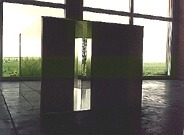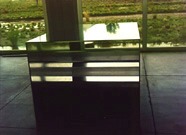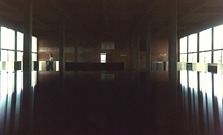


One of largest and most important collections of modern art in America isn't in a big city like L.A. or New York. It's in little Marfa, Texas, a town of 2,000 folks.
The Chinati Foundation is a large complex of over a dozen buildings that once were warehouses or part of an abandoned U.S. Army Fort. The buildings and some 300 acres were purchased by American minimalist artist Donald Judd and refurnished, largely with his own money, to display art. Unlike most art museums, which feature a smorgasbord of artists and a parade of changing exhibits, the Foundation's heart and soul is its permanent exhibits. As Judd wrote in the Foundation's catalog, "It takes a great deal of time and thought to install work carefully. This should not be thrown away. Most art is fragile and some should be placed and never moved again."
Placement has often been central in the thinking of minimalists. Dan Flavin's neon sculptures, for example, some of which were recently permanently installed here, were often placed with a specific location in mind, perhaps even the space where two walls met in a particular art gallery. (If when you hear the words "neon sculpture" you think of Chicago's O'Hare airport, consider this: the O'Hare sculpture is to Don Flavin's work as Michael Bolton is to Otis Redding.)
Donald Judd obviously loved this land; he lived in Marfa for decades and was one of the largest private landowners in western Texas when he died in 1994. This love is reflected, literally, in his 100 Mill Aluminum Works. These are metal boxes, arranged in a renovated artillery shed with floor-to-ceiling windows that allow the sky and earth to be mirrored in the polished surfaces. Some of the metal boxes have slit-like opening through which you can see the horizon framed and reflected.
The art at Chinati is mostly minimalist, and it might be facile to dismiss it all as silly, simplistic or self-indulgent. But to do that ignores the fact that the Minimalist movement, in the 1960's, was a swift kick to the head, overturning conventional definitions of what "art" was. Renaissance paintings by Rembrandt or Da Vinci -- sometimes labeled "representational" art -- were indeed complex, juggling issues like draftsmanship, color, light, shadow, composition, texture, space, and symmetry. For the minimalist, it was enough to focus on just one or two of these issues. Hence, for example, a painting which appears at first glance to be just a canvas of uniform color, upon color inspection, revels in subtle variations in hue and tone. Paintings like these might emphasize materials -- Robert Ryman, for example, painted blank white paintings with a variety of media, including gouache, casein, enamel, pastel, gesso, etc. -- or else explore the psychological responses we have to particular colors. Some of the issues Judd explored in his Aluminum Works were proportion, texture, material, and the relationship of the object to the surrounding (including the viewer). Imagine-- all that meaning in little polished rectangles of metal.
I saw these works seven years ago. As I write this now and remember the Works, I recall finding them extremely pacifying. The tranquilizing experience was not unlike that I had a year ago at a Japanese garden in Portland. The best part of the garden wasn't the over-crowded paths lined with bushes and bamboo, or the happy pond with people teasing the koi. It was a quiet sand and stone garden. It was a REAL rock garden, not one of those five dollar things you can buy at a New Age store, with a cheap wooden rake and a character-less black chips of gravel. In this garden, the larger stones were carefully placed to give them meaning and personality. One rock stood alone, aloof; the others were gathered together like children around a storyteller or elder.
Not only were the rocks like little people, but they were like little islands. The moss skirting each rock becomes grass, the raked sand between them become waves in an ocean. A universe in miniature is reproduced, with sea, land, sky. To the Chinese painter, rocks are the frameworks of the heavens and of earth; they are the "roots of the clouds." To learn to paint a rock is a prerequisite to learning to paint a mountain, which we might ascend to touch the sky.
As Liz and I sat silently contemplating, children would flit into the rock garden, glancing about, and leaving in a huff, saying, "There's nothing to see here." Which misses the point. In my understanding, Zen, like Minimalism, isn't about nothingness or emptiness, but absence of clutter. Less is more. The jumble of books, computers, desks, furniture--- things!--- piled around us causes untold, subconscious stress, as we worry about caring for them, worry about protecting them from damage or theft. When we remove objects from our presence, their place is taken by intangibles: space, peace, breathing room. When we escape from slavery to draftsmanship and representationalism, we can concentrate on texture, color, proportion, and, indeed, on a different comprehension of Beauty.
Site visited August, 1991. Tours at Chinati are given free of charge and without prior appointment every Thursday, Friday and Saturday between 1 pm and 5 pm. With advance notice, tours can be arranged at other times for $10 per person ($5 for students and senior citizens, free for Chinati members). Please call the office at (915) 729-4362 at least two days in advance to schedule a special appointment. The museum is closed on Sundays.
In addition to the Donald Judd Alumin Works, Chinati features the large sculpture "Monument to the Last Horse" by Claes Oldenburg, a tribute to Louie, the last cavalry horse at Fort Russell; and installations by John Chamberlain, Ilya Kabakov and others. An annual open house is held late in September or early in October and features such guests as prominent artists, art historians, actors, and musicians from around the world.
The Chinati Foundation homepage is here.
Back to Kitsch Tour U.S.A.
Back to Science Fiction and Humor Writing
Back to The Official Frank Wu Website homepage